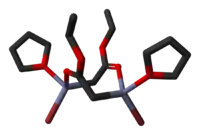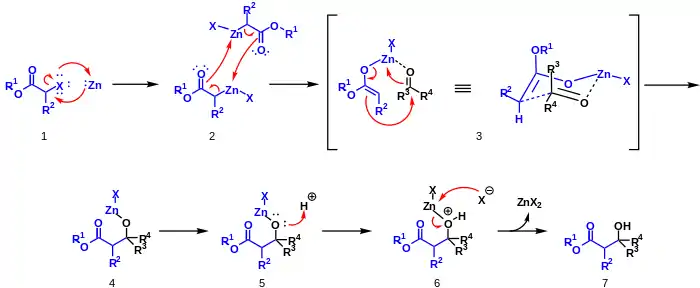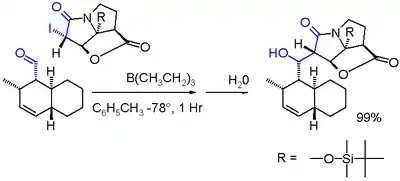Reformatsky reaction
The Reformatsky reaction (sometimes spelled Reformatskii reaction) is an organic reaction which condenses aldehydes or ketones with α-halo esters using metallic zinc to form β-hydroxy-esters:[1][2]

| Reformatsky reaction | |
|---|---|
| Named after | Sergey Reformatsky |
| Reaction type | Coupling reaction |
| Identifiers | |
| Organic Chemistry Portal | reformatsky-reaction |
| RSC ontology ID | RXNO:0000036 |
The organozinc reagent, also called a 'Reformatsky enolate', is prepared by treating an alpha-halo ester with zinc dust. Reformatsky enolates are less reactive than lithium enolates or Grignard reagents and hence nucleophilic addition to the ester group does not occur. The reaction was discovered by Sergey Nikolaevich Reformatsky.
Structure of the reagent
The crystal structures of the THF complexes of the Reformatsky reagents tert-butyl bromozincacetate[5] and ethyl bromozincacetate[6] have been determined. Both form cyclic eight-membered dimers in the solid state, but differ in stereochemistry: the eight-membered ring in the ethyl derivative adopts a tub-shaped conformation and has cis bromo groups and cis THF ligands, whereas in the tert-butyl derivative, the ring is in a chair form and the bromo groups and THF ligands are trans.
  |   |
Reaction mechanism
Zinc metal is inserted into the carbon-halogen bond of the α-haloester by oxidative addition 1. This compound dimerizes and rearranges to form two zinc enolates 2. The oxygen on an aldehyde or ketone coordinates to the zinc to form the six-member chair like transition state 3. A rearrangement occurs in which zinc switches to the aldehyde or ketone oxygen and a carbon-carbon bond is formed 4. Acid workup 5,6 removes zinc to yield zinc(II) salts and a β-hydroxy-ester 7.[7]

Variations
In one variation of the Reformatsky reaction[8] an iodolactam is coupled with an aldehyde with triethylborane in toluene at -78 °C.

See also
- Aldol reaction
- Blaise reaction
- Claisen condensation
- Example use in total synthesis: Mukaiyama Taxol total synthesis (B ring construction)
References
- Reformatsky, S. (1887). "Neue Synthese zweiatomiger einbasischer Säuren aus den Ketonen". Berichte der Deutschen Chemischen Gesellschaft. 20 (1): 1210–1211. doi:10.1002/cber.188702001268.
- Reformatsky, S. (1890). J. Russ. Phys. Chem. Soc. 22: 44. Missing or empty
|title=(help) - Shriner, R. L. (1942). "The Reformatsky Reaction". Organic Reactions. 1: 1–37. doi:10.1002/0471264180.or001.01. ISBN 9780471264187.
- Rathke, M. W. (1975). "The Reformatsky Reaction". Organic Reactions. 22: 423–460. doi:10.1002/0471264180.or022.04. ISBN 0471264180.
- Dekker, J.; Budzelaar, P. H. M.; Boersma, J.; van der Kerk, G. J. M. & Spek, A. J. (1984). "The Nature of the Reformatsky Reagent. Crystal Structure of (BrZnCH2COO-t-Bu · THF)2". Organometallics. 9 (3): 1403–1407. doi:10.1021/om00087a015.
- Miki, S.; Nakamoto, K.; Kawakami, J.; Handa, S.; Nuwa, S. (2008). "The First Isolation of Crystalline Ethyl Bromozincacetate, Typical Reformatsky Reagent: Crystal Structure and Convenient Preparation". Synthesis. 2008 (3): 409–412. doi:10.1055/s-2008-1032023.
- Kurti, L.; Czako, B. Strategic Applications of Named Reactions in Organic Synthesis; Elsevier: Burlington, 2005.
- Lambert, T. H.; Danishefsky, S. J. (2006). "Total Synthesis of UCS1025A". Journal of the American Chemical Society. 128 (2): 426–427. doi:10.1021/ja0574567. PMID 16402826.